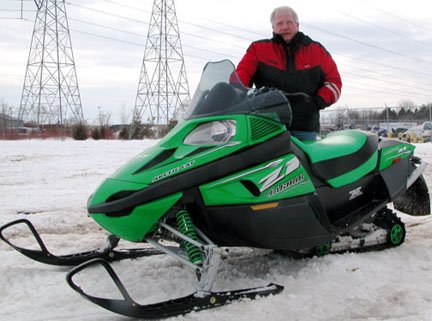 AP Reports Sled Sales Tough
AP Reports Sled Sales ToughA recent business article by Associated Press reiterates the fact that what snowmobile dealers (and manufacturers) need is simple: SNOW!
The AP news writer quoted a suburban Minneapolis snowmobile dealer as saying that his shop returned more than 50 Arctic Cat snowmobiles and ATVs rather than try to survive another low snow sales season. The AP writer’s research noted that Polaris snowmobile sales dropped more than half, with 2006 profits down 22 percent.
Although Arctic Cat sled sales were more stable the past five seasons, Cat’s sales were down more than 5 percent from ’06. Faced with high incentives to sell sleds, overall profits were impacted, leaving Cat down 16 percent from the previous year.
With nearly a decade of poor snow seasons, snowmobile manufacturers have seen worldwide sales decrease from a peak of 260,000 sleds in 1997 to about 160,000 this year.

The writer notes that despite losing its deal with KTM, Polaris has freed up its Victory motorcycle brand to enter more niches. The all-new Victory Vision touring bike enters the profitable Honda Gold Wing territory.
Polaris which has sold all-terrain vehicles to the US military is trying to gain more sales there.
Polaris reacted to the continued poor seasonal sales of snowmobiles by reducing production of its 2007 models by 40 percent; hoping to let dealers clean inventory. As a matter of public record, snowmobiles were less than 10 percent of Polaris sales.
With no motorcycle option to boost profitability and sales, Arctic Cat cut sled production by only four percent. The company stands with its traditional seasonal sales program of sleds for winter and “wheelers” for summer. Sleds make up around one-third of Cat’s sales, but even so, the company recently laid off 65 workers readjusted its full-year profit forecast downward. to $1.07 to $1.15 per share, down from $1.13 to $1.19 per share.
Fortunately for both sled makers, senior management is experienced with Polaris President and Chief Operating Officer Bennett Morgan a seasoned veteran of the snow wars. He sees Polaris readily capable of ramping up production—and sales—once the snow flies again.
Morgan was quoted as saying that Polaris "… took some tough medicine. … we feel much better about our snowmobile business today than we did in April."
There had been speculation that Polaris would get out of its legacy business of snowmobiles. Morgan stated flatly that Polaris has never considered spinning off its snowmobile business, emphasizing: "It is the heart and soul of this company."
The other snowmobile makers from Canada and Japan are faced with similar problems in the sled market, but Japanese maker Yamaha with its myriad of power products from motorcycles to PWC to sleds has the deepest pockets to weather the (lack of) storm.

Canada’s Bombardier Recreational Products (BRP), which supports its Ski-Doo line of snowmobiles with CanAm ATVs, Evinrude outboards and its line of Sea-Doo personal watercraft, has ventured into new markets, creating a unique three-wheeled street-legal vehicle called the “Spyder.” This quasi-motorcycle is both capable of performance around town or across country as a touring machine.

Polaris has announced an expansion of its side-by-side Ranger utility vehicles with the addition of the sports Ranger RZR (see following article).
With sled sales down, the four companies that remain in the marketplace are looking for alternative products that are less dependent on seasonal fluctuations like snow and that have marketability in more geo-climatic areas.
But as Polaris’ Morgan noted, the snowmobile manufacturers will rebound with the arrival of snows.
© 2007 Snowmobilia/Jerry Bassett
To comment go to – http://www.amsnow.com/jerrysblog







































